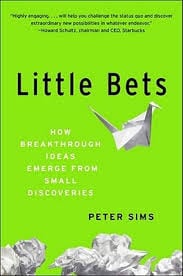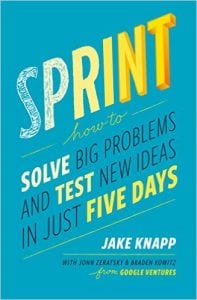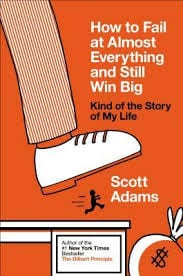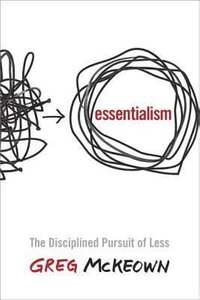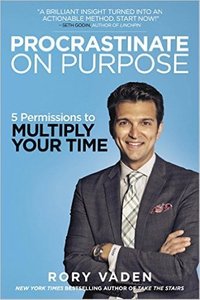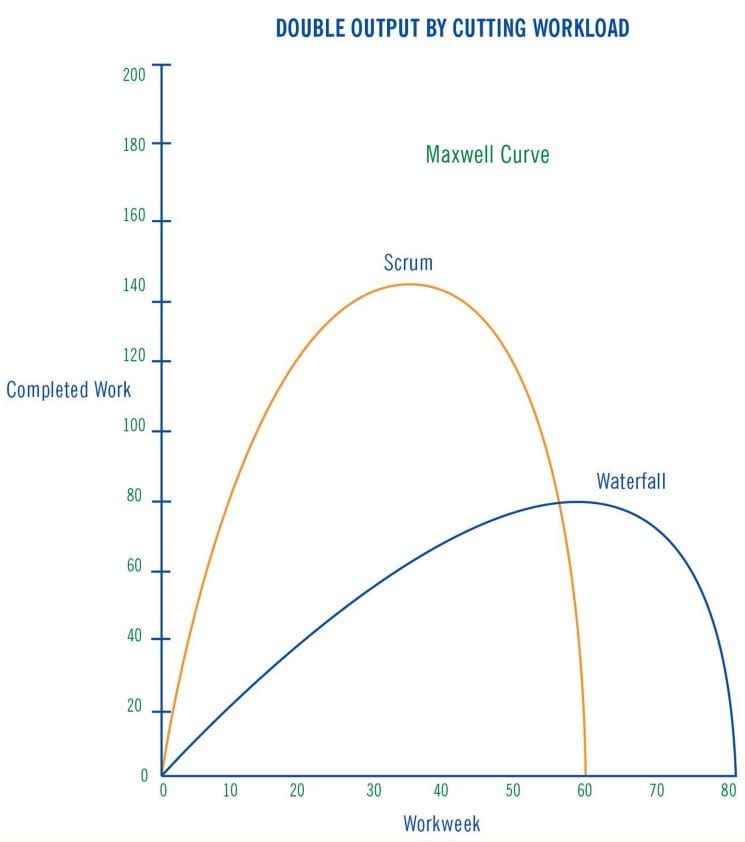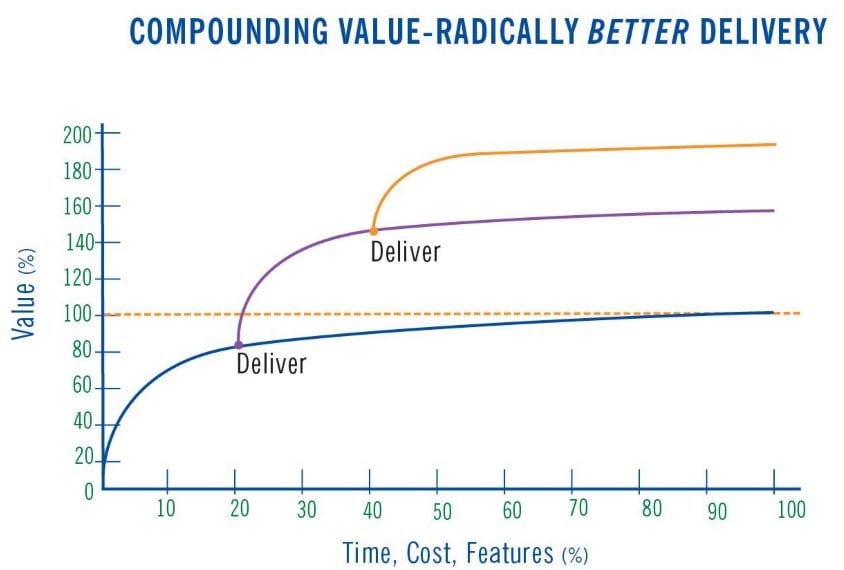The Sign of a Professional
The Checklist Manifesto by Atul Gawande
(Checklists) not only offer the possibility of verification but also instill a kind of discipline of higher performance.” – Atul Gawande, MD
1-Page PDF Summary of The Checklist Manifesto
Achieve Perfection with Imperfection
Little Bets by Peter Sims
By expecting to get things right at the start, we block ourselves psychologically and choke off a host of opportunities to learn.” – Peter Sims, Little Bets
People like Chris Rock, Frank Gehry and the Pixar filmmakers are perfectionists who systematically make mistakes to discover new ideas and develop great products. How is this possible?
Sprint
Sprint by Jake Knapp
No problem is too large for a sprint.“ – Jake Knapp
Google Ventures invests $300 million dollars in start-ups each year. To protect their investment Google Ventures helps these start-ups solve big problem and test new product ideas.
In an effort to solve problems and test new products quickly, Google Ventures designers Jake Knapp, John Zeratsky, Braden Kowitz have designed a rapid problem-solving method called ‘Sprint’.
Watch the following video to understand how you can solve big problems in just 5 days:
Goals vs. Systems
How to Fail at Almost Everything and Still Win Big by Scott Adams
Goals are for Losers” – Scott Adams, How to Fail at Almost Everything and Still Win Big
Fairly alarming statement by author Scott Adams (creator of Dilbert), but after reading his book ‘How to Fail at Almost Everything and Still Win Big’ I completely understand why.
The following video explores the difference between Goals & Systems. The 1-Page PDF Summary below provides an overview of three systems you can use to dramatically improve your odds of professional success.
1-Page PDF Summary of Insights
The Way of the Essentialist
The pursuit of success can be a catalyst for failure. Put another way, success can distract us from focusing on the essential things that produce success in the first place.” – Greg McKeown
The basic value proposition of Essentialism:
Only once you give yourself permission to stop trying to do it all, to stop saying yes to everyone, can you make your highest contribution towards the things that really matter.” – Greg McKeown
In the following video I summarize Greg’s book and provide a framework for preventing the non-essential from creeping into your life:
Focus Funneling
Insights from the book ‘Procrastinate on Purpose‘ by Rory Vaden.
Time to read: 6:36 minutes
Procrastination has evolved over the years.
Thanks to our ‘information age’ we have adopted an advanced form of procrastination called ‘priority dilution’.
“Priority Dilution has nothing to do with being lazy, apathetic or disengaged. Yet it is the same net result: We delay the day’s most important activities by consciously or unconsciously allowing our attention to shift to less important tasks…To someone struggling with Priority Dilution, it can sometimes feel like the harder they work, the more they fall behind. For every e-mail they send out, they get two in return. And each task they complete seems to hold behind it two more additionally that need to be done.” – Rory Vaden, Procrastinate on Purpose
We are bombarded by hundreds of requests (emails, phone calls, texts) and thousands of distractions throughout the day (advertisements, newsfeeds, status updates). All this information clouds our priorities and leads us into ‘reaction mode’.
In ‘reaction mode’ we don’t take the time to consider the significance of something.
Significance is different than importance.
I mistake importance for significance all the time. When I first had the idea to start my own business I took the time to build a business plan. A business plan seemed important at the time and it probably was important…up to a certain point. I spent weeks trying to perfect my business plan. Even after weeks of work my work on the business plan it still ‘felt’ important. However, looking back, the more time I spent on the business plan the less time I spent testing my ideas, building productive systems and hiring people to grow my business grow – all significant items that would have a lasting impact.
Minute-by-minute we all believe we are performing important tasks. As the days pass we look back at our results we realize how ‘unimportant’ many of those tasks were.
The main reason we believe things are more important than they really are is due to our sense of urgency. The pace needed to keep up with the information coming our way and the impatience of others around us causes us to think everything is urgent AND important.
“As you factor in a calculation for Significance, it begins to offset some of the weight and pull of Urgency— which is the exact cause of Priority Dilution!” – Rory Vaden
The 3rd Dimension
The feeling of importance and the sense of urgency form our two-dimensional time management model. However, when we expand our thinking to consider the ‘significance of a result’ we uncover a third dimension of time management: significance.
“Those making the Significance calculation are operating on a plane of different perspective. They are considering not only what matters now but also what matters later. Therefore that person is better able to resist the temptation of the tyranny of the urgent— which is exactly what ultra-performers do.” – Rory Vaden
By thinking “how long will this matter?” we move truly important items to the top of the priority list. By considering the impact of our next action on our life and the lives of others we can see that most things are just noise.
However, it’s unrealistic to pause and consider the ‘significance’ of every option we face. We need a system to automatically filter external requests and actionable insights.
The Focus Funnel
Author Rory Vaden suggests that we filter each idea/request through the following stages before we commit our time to completing it:
- Eliminate: Is this something I can live without?
- it’s OK to say no…
- Automate: Is this something that can or should be systematized?
- invest in systems that pay off in the long run (this will compound your free time)
- Delegate: Is this something that can be completed by someone?
- let go of your need for perfection...
- Procrastinate on Purpose: Is this something that can wait until later?
- now may not be the best time to take action (wait for more information or wait to batch process this item with a group of similar items)…
- Concentrate : Is doing this thing the most significant use of my time?
By the time we think through steps 1 through 4 you end up ‘concentrating’ on something that is likely to have a significant impact.
If we can’t eliminate it then we try automating it. If we can’t automate it then we try to delegate it. If we can’t delegate it then we try procrastinating on it (deliberating waiting until you have all the information necessary to confidently completely the task OR until the task is deemed unnecessary). If the thought of procrastinating on something is unbearable or simply unacceptable, then we have permission to focus all your energy on the item until it is complete.
“Until you accomplish your next most Significant priority, everything else is a distraction.” – Rory Vaden
When we don’t filter items through our ‘focus funnel’ we inevitably begin:
“Trading the things we know we should be doing for the things that other people want us to do. Allowing ourselves to be commanded by the Tyranny of the Urgent into things that are not Significant, but they are in front of us.” – Rory Vaden
Author Rory Vaden identifies each stage of the focus funnel as a ‘permission’.
- We fail to ignore things because we haven’t given ourselves permission to say no.
- We don’t hand things off to others because of our need for perfection.
- We don’t allow ourselves to spend time building systems that will serve us in the future because we need to respond to every request in the present.
- We don’t allow ourselves to delay certain low priority action items because we need to get our inbox/to-do list to zero!
But…
- We always have a choice (we just need to recognize the trade-off).
- We can learn to trust others with our work give them a chance to thrive.
- We can take some time today to build systems that will improve tomorrow.
- Most things can wait and waiting is often a wise decision when things are likely to change.
- We are allowed to block out our time and focus on a select significant things for the majority of our time.
The focus funnel is a very productive way to think.
Funnel Revision
I resonate with almost all the ideas in ‘Procrastinate on Purpose’ but based on my experience I there is one step missing from the funnel process: the 2-minute capture or complete.
The author suggests that every item we can’t ignore should go straight into the systemizing and delegation phase. However, depending on our current state of mind and the intensity of a situation we may not have the courage to ignore/eliminate certain items that should be ignored/eliminated. We might think (based on your current circumstances) that we can’t live without it. If it gets past our ‘elimination’ filter we might start building a system around it and waste a considerable amount of time doing so. If we go into the delegating phase we might waste a considerable amount of time and money doing so (creating a whole host of other problems in the process).
I suggest that we use the ‘2-minute rule’ (as explained in the book ‘Getting Things Done’ by David Allen) to initiate the focus funnel. The ‘2-minute rule’ states that we either complete an item within 2-minutes of receiving it or capture the details of the idea/request and schedule it to be completed at a later date.
The ‘2-minute rule’ prevents small but necessary items from piling up and it allows us to capture items that may seem critical at the time but end up being less critical when we check in them at later date (with a fresh perspective).
We can also use the ‘2-minutes rule’ to initiate the idea/request to see if it is worthwhile or to gather more data.
For example:
- take 2 minutes to list the steps needed to complete this task and the expected result/benefit.
- take 2 minutes to send an email to someone with experience in this particular area (asking for their advice).
- take 2 minutes to write a quick draft document on the topic.
- take 2 minutes to get a quote from a team member on how long they think it would take to complete
- take 2 minutes to get a quote from an outsourcing agency and find out how much they think it will cost.
Two minutes is long enough to take the action needed so we can stop thinking about it (for now). Two minutes is short enough to not disturb our current work task (you are able to easily remember where you left off and resume working – minimizing the switching cost associated from having to re-direct and re-focus our attention).
The TAKEAWAY
We need a systematic way to filter the things that come our way, otherwise we start living life according to other people’s agendas and never see the opportunity to leveraging the systems and people that can give us more room to concentration on what is truly important to us.
Give yourself the permission to ignore, invest, accept imperfect results, leave less significant things incomplete (for the time being) and focus on just one thing that could have a lasting impact.
“Work double-time part-time (on significant items) and you shall soon embrace the full-time free time.” – Rory Vaden
What Now?
Use the revised focus funnel (click here a condensed Task Filtering Flow Chart):
- If you feel a task is important, Take 2 Minutes to capture, initiate or complete the task.
- if you complete the task there is no need to continue down the focus funnel.
During scheduled blocks of time or when you receive a reminder, look back at that time and ask:
- Could I live without this task?
- If not, Eliminate it or move it to a someday/maybe list.
- Is it best to wait?
- If you are waiting on information that might render this task unnecessary you have permission to Procrastinate on Purpose
- Can I systematize it?
- If there is existing service, software application or decision-making model to automate this process, use them. If not, determine if it is worthwhile to set up a system that can Automate this task and free up your time. As a general rule: if it takes you 5 minutes to manually perform a daily task it is worthwhile to spend 30x that amount (150 minutes) building a system to automate that task.
- Can I delegate it?
- If an employee or coworker can do it 80% as good as you, Delegate it.
- If a freelancer can do it for less than 80% of your hourly rate, Outsource it.
If you can’t eliminate it, delay it, automate it, delegate/outsource it, then you must block out all distractions and Concentrate your effort on completing it yourself.
Scrum: The Art of Doing Twice the Work in Half the Time
Insights from the book ‘Scrum: The Art of Doing Twice the Work in Half the Time‘ by Jeff Sutherland.
Time to Read: 8:26 minutes
Do you find most projects start off great but end up being a total nightmare to manage midway through?
Thanks to Jeff Sutherland’s book ‘Scrum: The Art of Doing Twice the Work in Half the Time’ I no longer have project nightmares.
The Problem with Most Projects
The traditional method of executing a project goes something like this:
- one person is responsible for estimating and sequencing the activities needed to complete the project (makes assumptions for areas he/she is not an expert in)
- managers assign people to complete the activities
- the team sticks to the original plan until the project is complete (management assumes the original estimate will remain relevant throughout the entire project life-cycle)
- any change is seen as a threat to the project
- additional resources are spent trying to get the project back on track, according to the original (outdated) plan
This rigid approach to project management can often create products the customer doesn’t actually need in the end. It delivers a product that is more then they actually require and cost more money then they were willing to spend!
This traditional project management method is called the ‘Waterfall’ method. In the book ‘Scrum’, author Jeff Sutherland reflects on his experience with the ‘Waterfall’ method:
“The process was slow, unpredictable, and often never resulted in a product that people wanted or would pay to buy. Delays of months or even years were endemic to the process. The early step-by-step plans, laid out in comforting detail in Gantt charts, reassured management that they were in control of the development process – but almost without fail, we would fall quickly behind schedule and disastrously overbudget.” – Jeff Sutherland
The shortcomings of the ‘Waterfall’ method can be explained by the shortcomings of the human mind. Psychologists have found that we all use irrational mental shortcuts from time to time and are not aware that we are doing so. Psychologists call these shortcuts ‘cognitive fallacies’. Here are a two fallacies that the traditional ‘Waterfall’ method falls prey to:
1. Planning fallacy
The planning fallacy was first introduced by Daniel Kahneman and Amos Tversky in 1979. It states that we chronically underestimate the time it takes to complete something (even if we are aware of the phenomenon) because of our overconfidence in completing common tasks and our tendency to focus on a single isolated event without considering the influential factors.
A 1994 study called ‘Exploring the planning fallacy: Why people underestimate their task completion times’ asked 37 psychology students how long it would take them complete their thesis – identifying the best and worst-case scenarios. At the end of the study, researchers found that the actual completion dates occurred an average of 7 days later than the student’s worst-case estimates. Only 30% of students were able to stick to their original estimates.
We suffer from the planning fallacy whenever we estimate mid to large size projects.
“Estimates of work can range from 400 percent beyond the time actually taken to 25 percent of the time taken. The low and high estimates differ by a factor of sixteen. As the project progresses and more and more gets settled, the estimates fall more and more into line with reality until there are no more estimates, only reality.” – Jeff Sutherland
Therefore, a project plan is only useful if it can be refined in increments and updated according to the latest information we receive.
“The key is to refine the plan throughout the project rather than do it all up front. Plan in just enough detail to deliver the next increment of value, and estimate the remainder of the project in larger chunks. In Scrum, at the end of each iteration you have something of value that you can see, touch, and show to customers. You can ask them: “Is this what you want? Does this solve at least a piece of your problem? Are we going in the right direction?” And if the answer is no, change your plan.” – Jeff Sutherland
It is important to plan our projects. But we must ensure we do not ‘over plan’ our projects.
“A good plan executed violently now is better than a perfect plan executed next week” – General George S Patton Jr.
2. Sunken cost fallacy
If we use a large amount of time and resources to generate a project estimate we become overly attached to it. This attachment causes us to defend an original estimate, go over budget trying to maintain it and disregard new information that conflicts with it. When this occurs we are suffering from what psychologists call ‘the sunken cost fallacy’.
“The sunk-cost fallacy keeps people for too long in poor jobs, unhappy marriages, and unpromising research projects. I have often observed young scientists struggling to salvage a doomed project when they would be better advised to drop it and start a new one.” – Daniel Kahneman, Nobel Economist and author of ‘Thinking, Fast and Slow’
If our initial estimate is too detailed we forget the true intent of the project and make the ‘plan’ the priority.
These two fallacies cause endless frustration when managing projects.
A New Way
In the 90’s, Japanese professors Hirotaka Takeuchi and Ikujiro Nonaka did extensive research on some of the most effective companies in the world and found that they conducted projects in a radically different way then the Waterfall method.
Jeff Sutherland, author of ‘Scrum: The Art of Doing Twice the Work in Half the Time’, used Takeuchi and Nonaka’s research to develop a project management system called ‘Scrum’ in the early 1990’s. Since then companies like Google, Amazon, Salesforce.com, Toyota and the FBI have used Scrum and continue to use it.
“Scrum has its origins in the world of software development. Now it’s sweeping through myriad other places where work gets done. Diverse businesses are using it for everything from building rocket ships to managing payroll to expanding human resources, and it’s also popping up in everything from finance to investment, from entertainment to journalism. Scrum accelerates human effort— it doesn’t matter what that effort is.” – Jeff Sutherland
Scrum can be used in almost every environment and on every type of project. I’ve used Scrum on my engineering projects and I now use it manage my website.
The 7 Steps of a Scrum Project
Identify the product owner (visionary), Scrum master (team facilitator) and a small team of 3 to 9 people that have all the skills necessary to complete a project phase.
(Scrum Sprint Checklist PDF – receive a condensed one-page checklist of the Scrum method)
- Create and Prioritize a Backlog (product owner responsibility)
- List everything that needs to be completed by the team, for the entire project, in narrative format: who, what, why (who’ll be getting value from it, what exactly do they need and why do they need it – “As an X, I want Y, so that I can do Z”).
- make each item small enough to estimate.
- make each item independent of other items (items can be considered “complete” on their own).
- ensure each item is ‘testable’ when completed (determine a testing method that you can use deem the item “complete”).
- Rank the items in terms of their customer value.
- Items that can provide immediate value and with relatively very little risk should be at the top of the list (prioritize items based on how quickly they can be demonstrated and used to generate revenue).
- List everything that needs to be completed by the team, for the entire project, in narrative format: who, what, why (who’ll be getting value from it, what exactly do they need and why do they need it – “As an X, I want Y, so that I can do Z”).
- Refine and Estimate Backlog Items (team’s responsibility)
- As a team, assign a Fibonacci number to each item: 1, 2, 3, 5, 8, 13 (a natural progression in nature that humans naturally find easier to make comparisons with).
- Start with one of the hardest/most complex items and assign it a value of 13 (use a higher Fibonacci number, like 21, 34 or 55 for very large projects). Make a relative comparison to this first item when assigning values to all other items.
- ”Do not estimate the Backlog in hours, because people are absolutely terrible at that” – Jeff Sutherland.
- Conduct a Sprint Planning Session (lead by the Scrum master)
- Establish a fixed sprint duration for the project that is no longer than 4 weeks (most people run a 1 or 2 week Sprints).
- Have the team determine how many points they think they can complete during the first Sprint (after the first Sprint they will have a benchmark value to use for future Sprints – aiming for a few more points each successive Sprint).
- Once the team has committed to what they think they can finish in one Sprint, that’s it. It cannot be changed or added to.
- Make Work Progress Visible (Scrum master’s responsibility)
- Create individual post-it notes for each sprint item and put them in one of three columns: DO, DOING, DONE.
- Move an item to ‘done’ directly after completing it.
- Update the Burndown Chart at the start of each day (a graph with ‘Sprint points’ on the y-axis and ‘Sprint days’ on the x-axis – starting with the total initial number of story points selected for the Sprint)
- The end result should be a steep downward slope that ends with zero points remaining on the last day of the Sprint.
- Conduct Daily Stand-up Scrum Meetings (lead by the Scrum master)
- Each day, at the same time, for no more than fifteen minutes, the team and the Scrum Master meet and answer three questions:
- What did we do yesterday to help the team finish the Sprint?
- What can we do today to help the team finish the Sprint?
- What obstacles could slow down our progress?
- Each day, at the same time, for no more than fifteen minutes, the team and the Scrum Master meet and answer three questions:
- Host a Sprint Demonstration (team’s responsibility)
- Invite all project stakeholders (customer, product owner, management, etc.).
- Show the results of what was completed during the last sprint.
- Only show items that meet the ‘Definition of Done’ (it does not need to be a complete product, but it should have at least one functional feature).
- Conduct a Sprint Retrospective Session (lead by the Scrum master)
- Gather feedback and comments from the demonstration session.
- Get the team together and have candid, solution-oriented discussion to answer the following questions:
- What went well?
- What could have been better?
- How can we improve the next Sprint?
Repeat steps 1-7 (briefly re-assessing steps 1 & 2 each sprint) until the customer is satisfied with the end result.
When you follow this method of work you don’t need to work as much.
Maxwell Curve chart from the book ‘Scrum: The Art of Doing Twice the Work in Half the Time’ by Jeff Sutherland (Chapter 5)
Why Scrum Works
Scrum works great because it embraces the following truths:
Compounding Improvement
Thanks to daily standup meetings and retrospective sessions scheduled no longer than 1 month a Scrum project continuously improves. Each improvement is build upon the previous improvement. When you improve a project process in this fashion you experience compounding improvement (aka: exponential improvement).
Most people are unable to grasp the power of compounding (me included!). We are all linear thinkers by nature. If I told you to take 30 linear steps 1 meter at a time, how far would you get? Easy, 30 meters.
But what if I told you to take 30 exponential one-meter steps: 1m step + 2m step + 4m step, etc. How far do you think you would be able to go?
Taking 30 exponential steps you take your 1,000,000,000 meters away from where you started. With 30 exponential steps you would circle the earth 78,000 times.
By having short sprints and frequent demonstrations we are able to harness the power of exponential improvement on our projects.
80/20 Production
In 1896, Italian economist Vilfredo Pareto found that most things follow an 80/20 distribution – 80% of the land was owned by 20% of the population, 80% of the wealth was in the hands of 20% of people, 80% of his peas grew from 20% of the pea pods. The Pareto Principle has become known as the ‘law of the vital few’: the majority of the output comes from a vital few inputs. Translated to our projects: the majority of value we deliver comes from a vital few tasks.
By finding and focusing on the 20% of available tasks on a given project for a given sprint we reduce the chances of working on something the customer may not need. The sprint duration should only allow enough time for 20% of the initial project activities to be completed before the next demonstration.
Compounding Value Chart from the book ‘Scrum: The Art of Doing Twice the Work in Half the Time’ by Jeff Sutherland (Chapter 8)
When you deliver 80% value after each 20% time duration you end up delivering 350% of the expected project value (assuming you perform five 20% sprints during the project life-cycle – 80% value x 5 sprints = 350% overall value).
Reduced Decision Fatigue
If you don’t work in sprints (doing frequent demonstrations and retrospective sessions), you’re likely to waste a great deal of time doing things that are not essential to the project. This will require you to take extra time (overtime) to get the essential project components completed.
Working overtime leads to poor decision making. Poor decision making leads to mistakes, which leads to more work. It becomes a downward spiral towards burn out.
“People who work too many hours start making mistakes, which, as we’ve seen, can actually take more effort to fix then to create. Overworked employees get more distracted and begin distracting others. Soon they’re making bad decisions.” – CEO of Venture Capital firm OpenView states as detailed in the book ‘Scrum: Twice the work in the half the time’
Scrum validates results throughout the project lifecycle and ensures that very little time is wasted doing activities that produce minimal value. The system of Scrum forces you to be effective with your time and avoid overtime. When you reduce overtime you reduce decision fatigue and the rework that results from decision fatigue.
Intrinsic Motivation
In the book ‘DRIVE: The Surprising Truth About What Motivates Us‘, author Daniel Pink explains that people are driven by three powerful intrinsic motivations: purpose, mastery and autonomy. It turns out that intrinsic motivators last longer and are much more powerful than extrinsic motivators (i.e. more money).
Scrum taps into our three intrinsic motivators in the following way:
- Purpose: all team members establish and share a common goal to deliver the most value in the shortest amount of time.
- Mastery: continual improvement combined with visual progress generates a sense of mastery.
- Autonomy: team members focus on results instead of activities.
The TAKEAWAY
Use Scrum to make your projects vastly more enjoyable, rewarding and efficient than traditional project management methods.
What Now?
Turn your next project into a Scrum project by following the 7 steps of Scrum (click here for a handy one-page Scrum Sprint Checklist PDF).


